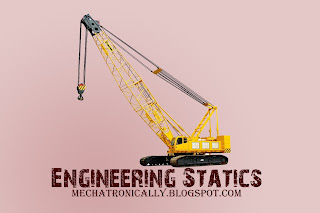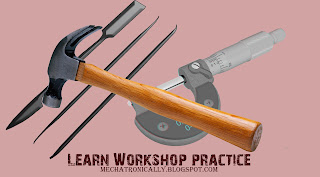Anyone who has never made a mistake has never tried anything new. "Albert Einstein"
Monday, 28 November 2016
Saturday, 26 November 2016
Introduction to Industrial Automation
The word Automation is derived from the Greek word "automatos", which means self acting. The word automation was first used in the mid of 1940, by the United States automobile industry to define automatic transfer of parts between different production machines, and their continuous processing at the machines. Before the advent of computer automation was just a small scale process, using mechanical actuators to automate some simply structured objects. However, the concept of automation took it's broad meaning with the advent of computers. Combination of computers with mechanically engineering structures and electronic circuitry, provided great flexibility to perform almost any type of process.
Automation is generally defined as the process of following the predetermined or fed sequence of operations (by the help of computer programming) with little or no involvement of human. This generally requires some specialized/dedicated equipment and devices. Human involvement can be minimized by the use of devices such as, sensors, transducers and actuators. With the involvement of such a devices the system can be made fully automated. These devices observe the manufacturing process in industry and send signal on the basis of changes occurring during any process, these signals are then processes by computer. The computer then takes the final decision on the basis of the signal received and then controls the process by sending control signals to the actuator or any other part of the circuit, as desired.
In this course we will see which automation strategies do the industries of today are following, and which strategies can be applied to optimize them further. The course will also introduce the devices that are essential part of any automated systems, like sensors, transducers and mechanical actuators. This is a core subject for mechatronics engineering students as it includes all aspects of mechatronics engineering, i.e. Mechanical, electronics, control and computer engineering.
 |
| Introduction to Industrial Automation |
Automation is generally defined as the process of following the predetermined or fed sequence of operations (by the help of computer programming) with little or no involvement of human. This generally requires some specialized/dedicated equipment and devices. Human involvement can be minimized by the use of devices such as, sensors, transducers and actuators. With the involvement of such a devices the system can be made fully automated. These devices observe the manufacturing process in industry and send signal on the basis of changes occurring during any process, these signals are then processes by computer. The computer then takes the final decision on the basis of the signal received and then controls the process by sending control signals to the actuator or any other part of the circuit, as desired.
In this course we will see which automation strategies do the industries of today are following, and which strategies can be applied to optimize them further. The course will also introduce the devices that are essential part of any automated systems, like sensors, transducers and mechanical actuators. This is a core subject for mechatronics engineering students as it includes all aspects of mechatronics engineering, i.e. Mechanical, electronics, control and computer engineering.
Quote 26 November 2016
The important thing is not to stop questioning. Curiosity has its own reason for existing. "Albert Einstein"
Friday, 25 November 2016
Introduction to Engineering Statics
Starting with the definition of Mechanics, it is a branch of physics that deals with the state of rest or motion of the bodies which are subjected to the external forces. Mechanics is further divided into three categories namely, rigid body mechanics, deformable body mechanics, and fluid mechanics. In this course we will stick to the rigid body mechanics as it provides the base for deformable body mechanics and fluid mechanics. Moreover, rigid body mechanics is an important tool to design and analyse the mechanical structures, components and electrical devices that we encounter in engineering.
Rigid body mechanics is further divided into two main areas namely, statics and dynamics.
Statics is concerned with the equilibrium of bodies, i.e. those that are at rest or moving with constant velocity. On the other hand, Dynamics is concerned with accelerated bodies. Statics is an important course of study for many engineering courses because it provides the basic knowledge to treat with those objects that are designed with an objective to remain in equilibrium through out it's life.
If we search for the origin of statics and dynamics, we find that, knowledge of statics evolved earlier than dynamics. We find the principles of statics in the work of Archimedes (287-212 B.C.). While on the other hand, we all know principles of dynamics are dependent on accurate and precise measurement of time. Galileo Galilei (1564-1642) is one of a major and earlier contributors to this category of mechanics.
Mechatronics engineering syllabus offer this course, because this is one of basic course of mechanical engineering. So mechatronics engineers must master this course to call themselves real mechatronics engineers.
 |
| Introduction to Engineering Statics |
Rigid body mechanics is further divided into two main areas namely, statics and dynamics.
Statics is concerned with the equilibrium of bodies, i.e. those that are at rest or moving with constant velocity. On the other hand, Dynamics is concerned with accelerated bodies. Statics is an important course of study for many engineering courses because it provides the basic knowledge to treat with those objects that are designed with an objective to remain in equilibrium through out it's life.
If we search for the origin of statics and dynamics, we find that, knowledge of statics evolved earlier than dynamics. We find the principles of statics in the work of Archimedes (287-212 B.C.). While on the other hand, we all know principles of dynamics are dependent on accurate and precise measurement of time. Galileo Galilei (1564-1642) is one of a major and earlier contributors to this category of mechanics.
Mechatronics engineering syllabus offer this course, because this is one of basic course of mechanical engineering. So mechatronics engineers must master this course to call themselves real mechatronics engineers.
Thursday, 24 November 2016
Introduction to Workshop Practice
We all know that science is growing at a fast rate and new theories emerge time to time. These new theories either offer efficient alternatives to the existing ones or add a new asset to life of human being. Besides that, it has been one of a prime interests of engineers to manufacture products utilizing scientific knowledge for the betterment of human being. To utilize the new theories and convert them into the useful products, engineers always felt the need of improved and advanced manufacturing processes, efficient tools and suitable materials.
Before 20th century, engineering was thought of converting scientific knowledge into the products of greater worth to the human beings, but it is not the same now. Engineers today, search for those processes, materials, and tools, that are efficient and have low or no impact on the environment. We can term it as pollution free engineering. Today engineers have to select only those technological methods which are environmental friendly.
Before 20th century, engineering was thought of converting scientific knowledge into the products of greater worth to the human beings, but it is not the same now. Engineers today, search for those processes, materials, and tools, that are efficient and have low or no impact on the environment. We can term it as pollution free engineering. Today engineers have to select only those technological methods which are environmental friendly.
 |
| Introduction to Workshop Practice |
In this course we will discuss conventional methods of manufacturing, as they provide base for our studies, and the modern methods, tools, and materials of manufacturing that are alternatives to the conventional ones. In this way we will be able to grasp more information efficiently.
Wednesday, 23 November 2016
Introduction to Robotics
So many work has been done in the field of science. Scientists through their work, try to learn some characteristics of themselves. Science is often misconceived that it is some experimental and paper work, but not, Science(whatever branch) in one way or another tells us some features of scientists themselves. Physicists find the application of physics in human body, so does the chemists. This link between science and human can be seen in every field of science. Robotics is no different from other branches of sciences in terms of link between human and science. Though it seems different in a sense that, other sciences seek towards analysis, while robotics appreciate engineers towards synthesis.
Thus robotics is concerned with the synthesis of some physical and control features of human body. This is achieved by deploying mechanisms to give physical aspects and using sensors, actuators and computers to achieve control features. Thus it is clear that it incorporates different fields of science.
Complexity of this field, makes it obvious that any individual cannot grasp the entire field of robotics in his/her hand. So the branching of this field is not unusual. At this time robotics has four major areas, namely, Locomotion, Mechanical manipulation, Artificial intelligence, and Computer vision.
In this section of blog we will only cover the section of Mechanical manipulation, because we would be covering locomotion in Industrial Automation section, Artificial Intelligence in Software section, and Computer vision is not yet introduced at our blog.
 |
| Introduction to Robotics |
Complexity of this field, makes it obvious that any individual cannot grasp the entire field of robotics in his/her hand. So the branching of this field is not unusual. At this time robotics has four major areas, namely, Locomotion, Mechanical manipulation, Artificial intelligence, and Computer vision.
In this section of blog we will only cover the section of Mechanical manipulation, because we would be covering locomotion in Industrial Automation section, Artificial Intelligence in Software section, and Computer vision is not yet introduced at our blog.
Quote 23 November 2016
Love is when each person is more concerned for the other than for one's self. "David Frost"
World Fibonacci Day
Today is 23 November, and this day is considered as world Fibonacci day because, when we look at today's date, i.e. 11/23, it makes the first four digits of Fibonacci series. Fibonacci series starts with 1 and every next digit is the sum of previous two digits.
 |
| World Fibonacci Day |
Starting with the 1, we get next digit by adding previous two digits i.e. 0+1=1. Now we have two digits 1,1. Sum these two to get the next digit i.e. 1+1=2. The series becomes 1,1,2. Adding 1 and 2 we get the next digit i.e. 1+2=3. Now the series is 1,1,2,3. This is similar to today's date, i.e 11/23.
Happy Fibonacci Day to you!
Tuesday, 22 November 2016
Introduction to Mechatronics System Design
Mechatronics is the engineering field, a combination of major subfields i.e. mechanical engineering, electronics, computer engineering and control engineering. With the advancements in technology, the number of subfields multiply. Mechatronics engineers find ways to solve problem looking into every branch of science that is the reason why it has grown up so early after it's introduction. Recently to subfields i.e. telecommunications engineering and systems engineering are also included in this field.
 |
| Mechatronics System as a combination of mechanical systems, electronic systems, computer systems and control systems |
Mechanical engineering is used to design the structure of the system and drive mechanism. Electronic systems incorporates the electronic devices and circuits that will send and receive required signals in the form of electrical energy. Control systems define the stability and response of the system with respect to the given input. Computer systems convert the instruction written in the form of easy to understand program into the signals that drive the electronic circuits. Finally the output of the electronic circuit drives the mechanical systems.
Sensors and transducers are incorporated in the circuits to automate the systems. Artificially intelligent systems that take decisions on their own can also be made. Telecommunication engineering is applied to these systems for control the mechanisms from distant places. These are some of it's features but not all, there is lot more to explore in this field. This is our motivation to study this course.
Monday, 21 November 2016
Introduction to Applied Physics
Physics, like other branches of science, would not be explained without experimental observations and quantitative measurements. The core purpose of physics is to discover those limited number of those fundamental laws that are related to some natural phenomena, and to use them to create new theories that can help predict the consequences of other experiments. These fundamental laws are often in the form of some mathematical expressions, those expressions which help us understand and analyse the results of new experiments.
When an experiment cannot be explained using one or more than one of the existing theories, there is a need to devise or update the existing theories to the level where they can explain and analyse the experiment. Some theories have limitations while other which are general are not limited to some specifications. "For example, the laws of motion discovered by Isaac Newton (1642–1727) in the 17th century accurately describe the motion of bodies at normal speeds but do not apply to objects moving at speeds comparable with the speed of light." (Quoted From "Fundamentals of Physics" by Halliday and Resnick,) "In contrast, the special theory of relativity developed by Albert Einstein (1879–1955) in the early 1900s gives the same results as Newton’s laws at low speeds but also correctly describes motion at speeds approaching the speed of light." Here we say that Newton's theory was specific to the bodies moving with normal speeds, while, Einstein's theory was more general that can describe the motion of bodies moving with normal speeds as well as high speeds.
The physics which was developed before 20th Century is called Classical Physics. It includes all the experimental and theoretical work done in classical mechanics, electromagnetism and thermodynamics. The major contributions in the classical physics are provided by Newton. He is known to be one of the originators of the calculus.
The physics which began to develop near the end of 19th century is called Modern Physics. The motivation behind the discovery of this new era physics or modern physics was, that, many natural phenomena occurring in the nature were still undefined in scope of Classical Physics. This led to the development of new theories i.e. Theory of Relativity and Quantum Mechanics. Theory of relativity was developed by Einstein and it gave the scientists new ways to think about space, time, and energy. The quantum mechanics is the results of the hard work of number of distinguished scientists. It applies on both, microscopic and macroscopic worlds.
Thus, Physics is the core subject for many engineering courses, because it provides both experimental and mathematical explanation of the physical phenomena occurring in nature. It is important because it provides the explanation of other sciences as well. Our motivation towards studying this course is to understand and analyze many physical phenomena around us, which should be a hobby for an engineer.
Saturday, 12 November 2016
Introduction to Electric Circuits and Network Analysis
Electric circuit theory is the most fundamental and basic theory upon which electrical engineering and all of its branches(Power Electronics, Electric Machines, Control, Electronics, Communications, and instrumentation etc) are based. Power Electronics, Electric Machines, Control Systems, Instrumentation, and Electronic Devices are the core subjects for a mechatronics engineering student.
In mechatronics engineering, we are interested in controlling mechanisms(Mechanical) through the use of the some electronic devices and software program. While doing this we often come across the scenarios where we have to make meaningful interconnection of electronic devices to achieve the desired objective. Prior to the study the interconnections of electronic devices, it is necessary to study the interconnection of electrical devices.
The prime objective of interconnecting electrical devices with each other is to transfer the required amount of energy(electric) from one point to another. Interconnections made this way is is referred to as an electric circuit.
The prime objective of interconnecting electrical devices with each other is to transfer the required amount of energy(electric) from one point to another. Interconnections made this way is is referred to as an electric circuit.
An electric circuit is an interconnection of electrical elements.
 |
| A simple Electrical Circuit |
A simple electric circuit is shown above in the figure. In this course we will start from the basic and easy circuits and move towards more complex circuits. We will discuss in this course those techniques which will help us analyze the more complex circuits. Our objective in this course will be to discuss various network analysis techniques, which will tell us how the circuit responds when given a specific input.




















